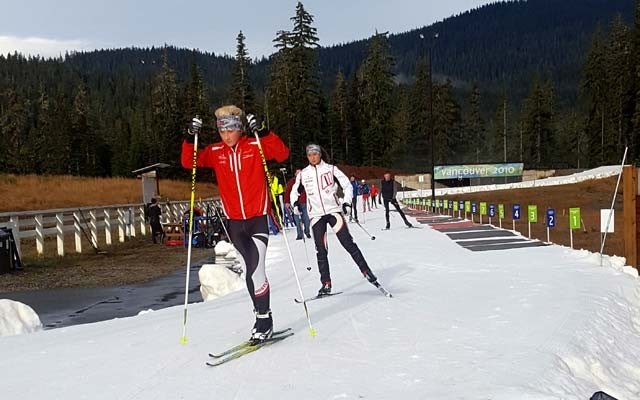Nordic athletes training at Whistler Olympic Park (WOP) got a boost to this season thanks to some remnants of last season.
For the second time, the park stored natural snow, dubbed Callaghan Gold, from the previous season to use in the following one.
The park opened to athletes on Oct. 29 and though wetter-than-expected conditions have affected the trails, WOP managing director Tim Hope has been pleased with their quality in light of the weather.
"Certainly these warm temperatures have taken its toll on it. We started with about a one-and-a-half-kilometre loop and are down to about 800 to 900 metres. We still have a main loop and still have the ability to use the range," he said. "It's held up, actually, remarkably well considering the monsoons that came through."
While weather plays a small role in when the loop is created, Hope explained the park receives a target date from sport groups and aims to hit it, give or take three or four days, as both the cross-country and biathlon seasons start early and athletes hope to hit the snow running.
"Early November is the time to allow for two or three weeks of on-snow preparation before the sports move into competition season," he said. "We are following their timeline, so to speak.
"The primary schedule for it is based on sport-usage needs."
Sea to Sky Nordics head coach Munny Munro said while conditions haven't been ideal, he appreciates all that Hope and his crew do to prepare the snow.
"It's been a little challenging, especially with the moisture and the wetness we've had, but overall, it's held up pretty good. From the club's perspective, we're super happy with it," he said.
With many of the club's athletes going to Canmore, Alta. to compete in early December, it's important to get those repetitions in, especially as the eastern skiers have their own snow saved up.
"It definitely helps to have that extra few hours because in cross-country skiing, our season is short. It's from November to maybe late March and we've got to get as much time on snow to train, especially for biathlon. There's a lot of skiing and a lot of shooting," Munro said.
Hope said the park learned a lot from its first snow-preservation attempt, so this year's early build is much improved from the 2014 access.
"We managed to almost double the amount of trail from the first year of it. That's based upon storing more snow and knowing how to treat it in a better manner," he said. "We found wet, dense snow is the key to building a large mass. A.J. Forest Products in Squamish has been a big help to us in terms of providing us wood waste hog fuel to lay on top of it, which insulates it. It's a combination of wood waste and saw dust that we have on there and we've found it's worked really well."
Hope said when the crew started the roughly weeklong process of setting up the snow, it was interrupted by warmer, rainier weather midway through and stopped briefly. When cooler, drier weather returned, allowing the snow to freeze up, construction resumed.
Opening day for the public is slated to be Nov. 24 and Hope would like to see the Callaghan Gold hold out until new snow starts to fall.
"The weather forecast is looking favourable. It doesn't take a lot of snow to get us open," he said.




